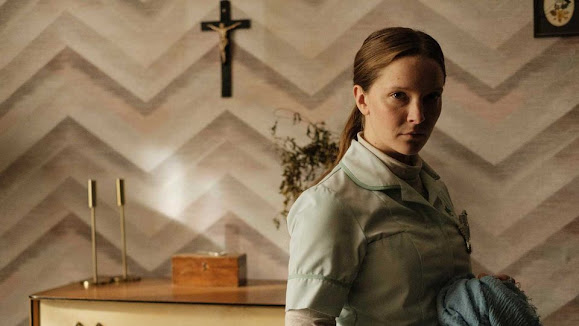SAINT MAUD: YOUR SAVIOR IS COMING
Rose Glass has acknowledged that Saint Maud can be interpreted in many different ways- whether Maud is actually suffering from an extreme mental disorder and imagining many of the film’s events or truly hearing God’s voice calling to her is up to the viewer’s discretion. Regardless, the film gives a really interesting take on the psychology and vulnerability of a trauma victim that can lead to sinister manifestations. If Saint Maud is meant to be taken literally, I know for certain that I won’t be trusting Welsh-speaking bugs anytime soon.
Rose Glass- writer/director
Morfydd Clark- Maud
Caoilfhionn Dunne- nurse
Jennifer Ehle- Amanda
Lily Frazer- Carol
Lily Knight- Joy
Noa Bodner- Hilary
Sona Vyas- agency worker
Faith Edwards- agency worker
Rosie Sansom- Esther
Rose Knox-Peebles- dead patient
Nancy- cockroach
Linda E. Greenwood- passerby on beach
Louise Port- birthday guest
Joanna Richardson- old woman
Susanne Schraps- Amanda’s friend
Fiona Thompson- nurse
Amanda Vinter- passerby
Mary Burke- executive producer
Andrea Cornwell- producer
Kharmel Cochrane- casting
Paulina Rzeszowska- production design
Isobel Dunhill- art direction
Anna Mould- set direction
Tina Kalivas- costume design
Emmalee Etherington- hair and makeup traine
Velina Iankova- makeup and hair assistant daily
Jacquetta Levon- hair designer/makeup designer/special makeup effects designer
Jane Maier- additional makeup & hair stylist/additional special makeup effects artist
Charlotte Dean- post-production supervisor
Anna Jancsó- production manager
Cordelia Hardy- first assistant director splinter unit
Naomi King- third assistant director
Ursa Banton-Miller- set dresser
Jessica Barrell- dailies graphic designer
Alannah Byrne- standby art director
Katie Clarke- production buyer
Annie McClure- home economist
Ysra-el St. Clair Miller- set dresser
Anna Oldham-Cooper- prop maker
Robyn Wilton- additional standby props/art department assistant/art trainee
Kerrie Bryant- visual effects producer: Technicolor
Zoe Cousins- digital film bureau
Danielle Dunster- VFX production coordinator/visual effects coordinator
Kate Warburton- VFX executive producer
Rachael Evelyn- stunt performer
Nadia Hansell- stunt double for Morfydd Clark
Teresa Adamson- additional 2nd assistant camera
Julia Green- splinter unit 1st assistant camera
Veronica Keszthelyi- additional second assistant camera
Alison Martin- camera trainee
Laura Radford- additional stills photographer
Luciana Riso- director of photography: Kohl Dance Company
Alison Streatfield- second assistant camera
Joelle Cochrane- casting assistant
May Douglas- casting assistant
Ariane Mason- casting assistant
Grace James- costume trainee
Mia Hope Radford- additional costume assistant
Sophie Billington- digital film bureau
Emma Liu- assistant digital intermediate producer
Chloe Warner-Harris- online editor
Jess Waluga- additional location manager
Lesley Jackson- composer agent
Jen Moss- music supervisor
Shaida Kazemi- script supervisor
Claire Ashton- stand in for Jennifer Ehle
Francesca Castelbuono- production secretary
Celine Coulson- senior development and production executive: Film4
Lauren Dark- creative executive: Film4
Simone Dawkins- floor runner
Grace Dickinson- animal wrangler
Rose Dyfebeedell- medical advisor
Daisy-May Hudson- producer’s assistant
Kristin Irving- production and development executive: BFI
Emily Leach- production executive: Film4
Jessica Moran- production coordinator
Katie Volker- additional production assistant
Sarah Nichols- thanks
Judy Spours- thanks
Thora Woodward- thanks
Eva Yates- thanks
Saint Maud is now streaming on Hulu, Amazon Prime, and Paramount+.


Comments
Post a Comment